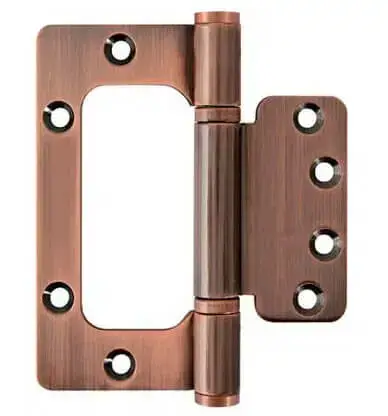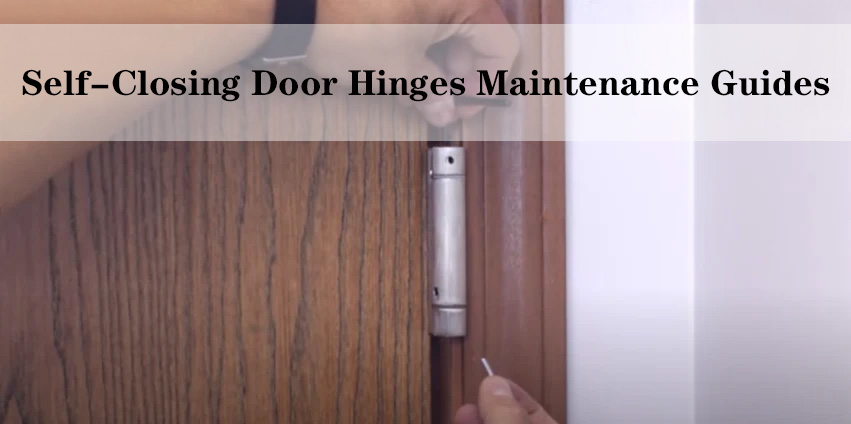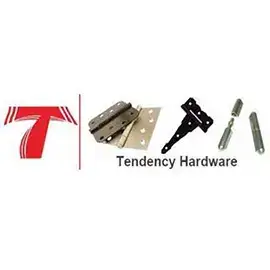
Flush hinges are a type of hinge commonly used in various carpentry and joinery projects. Unlike more traditional hinges, flush hinges are designed to fit perfectly within the thickness of the door and frame, ensuring a seamless and elegant finish. This unique design not only provides a clean and unobtrusive look but also makes them an ideal choice for a variety of applications, especially where space is at a premium or where a minimalistic aesthetic is desired.
These hinges are often found in kitchen cabinets, cupboard doors, and lightweight interior doors, offering a blend of functionality and style. Their construction varies, with some being made from robust materials like brass or stainless steel, suitable for heavier use, while others are crafted from lighter materials for less demanding applications.
Importance in Home Improvement and DIY Projects
In the realm of home improvement and DIY, the choice of hardware can profoundly impact both the functionality and aesthetic appeal of your projects. Flush hinges, with their sleek profile and ease of installation, have become increasingly popular among DIY enthusiasts and professional builders alike. They are not only straightforward to install but also require minimal tools and preparation, making them a go-to choice for quick renovations or updates.
Furthermore, understanding how to choose and properly install flush hinges is crucial for ensuring durability and longevity in your projects. A well-installed hinge not only enhances the appearance of a door or cabinet but also ensures smooth operation and reduces wear and tear over time.
In the following chapters, we will delve into the specifics of these hinges, offering insights on selecting the right type for your project, detailed installation instructions, and tips for maintenance. Whether you’re a seasoned DIYer or just starting your journey in home improvement, this guide aims to equip you with the knowledge and confidence to successfully incorporate flush hinges into your projects.
Chapter 1: Understanding Flush Hinges
Definition and Basic Mechanics
Flush hinges are a type of hardware pivotal in the functionality of doors, cabinets, and various other fixtures. Unlike traditional hinges, which are composed of two separate leaves, flush hinges are designed with one leaf that nests into the other when closed. This unique design allows for a seamless, almost invisible appearance when the door or cabinet is closed, making them ideal for a minimalist or modern aesthetic. The mechanics of a flush hinge are straightforward: when the door is opened, the leaves separate, allowing for movement; when closed, they come back together in a flush position with the surface.

Different Types of Flush Hinges
There are several types of flush hinges, each serving different purposes and aesthetics. The most common types include:
Standard Flush Hinges: These are the most basic form, often used in lightweight doors and cabinetry.
Butterfly Flush Hinges: Named for their shape, these are decorative and functional, suitable for light to medium weight applications.
Lift-Off Flush Hinges: These allow a door to be removed easily without unscrewing the hinge itself, ideal for furniture or cabinets that require frequent disassembly.
Each type of flush hinge has its specific application, depending on the weight of the door or panel and the desired look.
Advantages of Using Flush Hinges
Flush hinges offer several advantages, making them a popular choice among homeowners and professionals:
Space-Saving Design: Their ability to sit flush against doors and panels saves space, making them ideal for small rooms or furniture.
Aesthetic Appeal: Flush hinges offer a clean, unobtrusive look that complements modern interior design.
Ease of Installation: Generally, these hinges are easier to install than traditional hinges, as they require fewer screws and less alignment.
Chapter 2: Choosing the Right Flush Hinges
Factors to Consider When Selecting Flush Hinges
When choosing flush hinges, several factors should be considered to ensure they are fit for purpose:
Weight Capacity: It’s crucial to select hinges that can support the weight of your door or cabinet.
Door Material: The material of the door affects the type of hinge needed; heavier materials like solid wood require sturdier hinges compared to lighter materials like MDF or plywood.
Usage Frequency: For doors or cabinets used frequently, more durable hinges are recommended.
Material and Durability Concerns
Flush hinges are available in various materials, each with its strengths and weaknesses:
Steel Hinges: Known for their strength and durability, suitable for heavier doors.
Brass Hinges: Offer an aesthetic appeal with decent durability, ideal for lighter doors.
Stainless Steel Hinges: Best for moisture-prone areas due to their rust resistance.
When selecting materials, consider the environment where the hinge will be used. For example, stainless steel is preferable in high humidity areas to prevent rust.
Aesthetic Considerations
While functionality is key, the visual aspect of flush hinges should not be overlooked. Choose a finish that complements the color and style of the door and room. Popular finishes include polished brass for a classic look, brushed nickel for a contemporary feel, and black or oil-rubbed bronze for a more rustic or industrial appearance.

Chapter 3: Tools and Materials Needed for Installation
Comprehensive List of Required Tools
For a successful installation of flush hinges, it’s essential to have the right tools on hand. Here’s a checklist:
Screwdrivers: A set of flat-head and Phillips screwdrivers for tightening and adjusting screws.
Drill: An electric or battery-powered drill for making pilot holes.
Drill Bits: Various sizes for drilling pilot holes corresponding to the size of your screws.
Measuring Tape or Ruler: For precise measurements to ensure correct placement of the hinges.
Pencil or Marking Tool: To mark drilling spots and alignment.
Level: To ensure the door or cabinet is perfectly horizontal or vertical during installation.
Chisel: For mortising the door or frame, if necessary, for the hinge to fit.
Hammer: Useful for minor adjustments or for use with the chisel.
Each tool has a specific role, ensuring the installation process is smooth and accurate.
Selecting the Right Materials for Your Project
Choosing the right screws and other fittings is crucial for a secure installation:
Screws: Ensure they are the correct size and length for your hinge and material. Longer screws provide more stability in solid wood, while shorter screws are suitable for thinner materials.
Quality Markers: Look for screws made from durable materials like stainless steel or brass for longevity and rust resistance.
Chapter 4: Preparing for Installation
Step-by-Step Preparation Guide
Inspect the Door and Frame: Check for any damage or irregularities that might affect the installation.
Remove Existing Hinges (if applicable): Unscrew and gently remove any existing hinges.
Clean the Area: Ensure the hinge area on the door and frame is clean and free of debris.
Safety Tips and Preparatory Measures
Wear Safety Gear: Eye protection is recommended when drilling or chiseling.
Secure the Door or Cabinet: Make sure the door or cabinet is stable and won’t move during installation.

Chapter 5: The Installation Process
Installing flush hinges might seem daunting at first, but with the right tools and a step-by-step approach, you can achieve professional-looking results. Let’s dive into the installation process.
1. Detailed Installation Instructions
Before you start, ensure you have all the necessary tools and materials. This includes your flush hinges, a screwdriver or drill, chisel, hammer, ruler or measuring tape, and pencil.
Step 1: Marking the Door and Frame
Begin by aligning the hinge on the door where you want it installed. Use a pencil to mark the hinge outline. Repeat this process on the door frame, ensuring the marks on the door and frame align precisely.
Step 2: Cutting and Chiseling the Mortise
Using a chisel and hammer, carefully carve out the mortise – the recess in the door and frame where the hinge will sit. The depth of the mortise should be equal to the thickness of the hinge, ensuring it sits flush with the surface.
Step 3: Positioning the Hinge
Place the hinge in the mortise to check the fit. It should sit flush with the surface without any gaps.
Step 4: Securing the Hinge with Screws
Once you’re satisfied with the fit, secure the hinge with screws. Start by drilling pilot holes, then fasten the screws. Be careful not to over-tighten, as this can strip the holes or damage the hinge.
Step 5: Attaching the Door to the Frame
Align the door with the frame and attach the other side of the hinge. Ensure the door opens and closes smoothly.
Step 6: Final Adjustments
Make any necessary adjustments to ensure the door hangs evenly and there’s no sticking or misalignment.
2. Common Mistakes and How to Avoid Them
Mistake 1: Incorrect Measurement and Marking
Accuracy is key. Double-check your measurements before cutting. Use a sharp pencil for precise markings.
Mistake 2: Over-tightening Screws
This can strip the wood and damage the hinge. Tighten until secure, but don’t force it.
Mistake 3: Misalignment of Hinges
Use a level to ensure your hinges are perfectly aligned. Misaligned hinges can cause the door to hang incorrectly.
Tips for Prevention and Correction
If you make a mistake, don’t panic. Most errors can be corrected with a little patience. Fill stripped screw holes with wood filler and re-drill, or re-chisel carefully if the mortise is off.
Installing flush hinges is a rewarding DIY project that enhances the functionality and aesthetics of your doors. With these detailed instructions and tips, you’re well on your way to success. Next, we’ll move on to the finishing touches and testing to ensure a perfect fit.
Chapter 6: Finishing Touches and Testing
Once your flush hinges are installed, it’s time to make the final touches and ensure everything is working smoothly.
1. Ensuring Alignment and Smooth Functioning
Checking Alignment of the Hinges
Use a level to check the alignment of the hinges. They should be perfectly horizontal and in line with each other. Misaligned hinges can cause the door to hang incorrectly or not close properly.
Testing the Door Swing and Fit
Open and close the door several times. It should swing smoothly without any sticking or scraping. Ensure there’s even spacing around the edges of the door when closed.
Adjusting for Smooth Operation
If the door is not operating smoothly, adjust the hinges. This may involve loosening the screws, repositioning the hinge slightly, and then retightening.
2. Final Checks and Adjustments
Lubricating the Hinge
Apply a small amount of lubricant to the hinge pivot points. This helps in ensuring smooth motion and prevents squeaking.
Tightening All Screws
Go over all the screws one more time and tighten them if necessary. Avoid over-tightening.
Final Inspection and Cleanup
Do a final inspection of the door and clean up any debris or dust from the installation process.
Chapter 7: Maintenance and Care for Flush Hinges

Maintaining your flush hinges is key to their longevity and functionality.
1. Routine Maintenance Tips
Regular Cleaning and Lubrication
Clean the hinges regularly with a soft cloth to remove dust and debris. Lubricate the hinges every six months to ensure smooth operation.
Checking and Tightening Screws Periodically
Every few months, check the screws and tighten them if they have become loose.
Inspecting for Wear and Tear
Regularly inspect the hinges for signs of wear and tear. Early detection of problems can prevent more significant issues down the line.
2. Troubleshooting Common Issues
Squeaky Hinges: Causes and Fixes
Squeakiness is usually due to lack of lubrication. Apply a silicone-based lubricant to fix this issue.
Stiffness in Hinges: How to Loosen
If the hinge is stiff, lubrication is often the solution. In severe cases, you may need to adjust or replace the hinge.
Hinge Corrosion: Prevention and Treatment
To prevent corrosion, use stainless steel or coated hinges in high-moisture areas. If corrosion occurs, clean the hinge and apply a protective coating.
Conclusion
Choosing and installing flush hinges might seem like a minor task, but it significantly contributes to the overall functionality and appearance of doors, cabinets, and furniture. By understanding the different types, considering essential factors during selection, and following the correct installation process, you can achieve a seamless and polished look for your home or furniture project. Regular maintenance will also ensure that the hinges operate smoothly for years to come, providing both functionality and aesthetic appeal to your living spaces.























